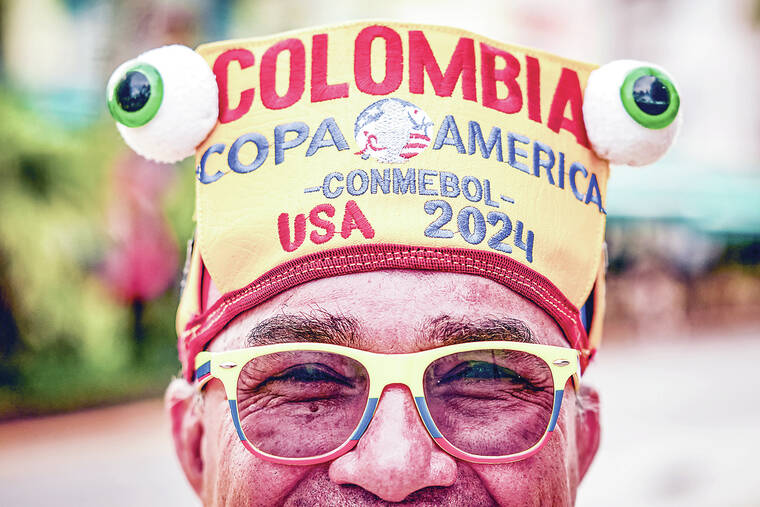Argentina vs. Colombia in Miami: A home game for both teams
MIAMI — Never was there any doubt that Miami, the nation’s most Pan-American city, was the most fitting place to host the final game of the Copa America, a South American soccer tournament that is being held in the United States for only the second time in a century.
But even the tournament’s organizers could not script a matchup like the one that will take place Sunday night between Argentina and Colombia — two countries that, on any given day, would be received like the home team in South Florida.
ADVERTISING
“That stadium is not going to feel like you’re in Miami — or in the U.S., for that matter,” said Juan C. Zapata, who was the first Colombian American elected to the Florida Legislature. “It is a very Miami final.”
The tournament, which started June 20, has lost some of its trademark South American feel being played entirely in the United States, with empty seats at some matches and players complaining about the surfaces of several fields. But the setting of the final may restore some of Copa America’s typical festive energy.
Argentina gets the most attention from American soccer fans thanks to star Lionel Messi, whose move to Fort Lauderdale last year caused a veritable frenzy. But Florida, while home to the largest Argentine population in the country (about 66,000 people as of 2021), has a far larger number of Colombians (more than 400,000). Their longtime presence in the Miami area has contributed to the cuisine (bandeja paisa) and the music (Shakira).
Both populations are heavily concentrated in South Florida, where the culture is so inescapably Latin American that most residents know the difference between an Argentine empanada (wheat flour, baked) and a Colombian one (corn flour, fried).
The region is such a potpourri of immigrants from the Western Hemisphere and their descendants that many Copa America teams with large expat populations (Venezuela’s, Jamaica’s and Brazil’s, for example) would have felt at ease playing at the Hard Rock Stadium in Miami Gardens. Even Canada, a semifinalist in the tournament, which included some teams from outside South America, would have drawn some Canadian snowbirds if it were not July.
Large numbers of Colombians began to settle in South Florida in the 1980s, often fleeing violence. Some Argentines arrived in the 1970s during a military dictatorship in their country, and many others escaped a turbulent economy a quarter-century ago.
Like many other U.S. citizens of Latin American origin in Florida, Argentine Americans and Colombian Americans for many years tended to lean Democratic, said Eduardo A. Gamarra, a professor of politics and international relations at Florida International University who directs the Latino Public Opinion Forum. (A prominent exception is Cuban Americans, who always leaned Republican.)
But Colombian Americans often held conservative views when it came to Colombian politics. Spying an opening, Florida Republicans began making a concerted effort around 2016 to win them over. They have largely succeeded, Gamarra said. Argentine Americans have also shifted right.
“These are two conservative communities now,” said Gamarra, a soccer fan who is originally from Bolivia and plans to attend Sunday’s match.
Sen. Rick Scott, a Florida Republican up for reelection, has run a soccer-themed television ad during the Copa America. So has President Joe Biden.
The political overtures have taken place as South Florida has become a soccer hub, driven in part by Inter Miami, the Major League Soccer franchise owned in part by former star David Beckham, which signed Messi last summer. Stephen Ross, the real estate developer who owns the Miami Dolphins, has led a push for international soccer at the Hard Rock Stadium, which will host seven World Cup matches in 2026 (and receive about $36 million in public funding and services to do so).
CONCACAF, the confederation governing soccer in North and Central America and the Caribbean, has its headquarters in downtown Miami. FIFA, soccer’s international governing body, opened its U.S. office last year in the affluent suburb of Coral Gables. Argentina’s national soccer federation is working on major U.S. plans that include a $10 million training facility in North Bay Village, between Miami and Miami Beach.
Soccer has been good for business, said Leo Graziano, the Argentine-born CEO of Graziano’s Group, which runs 11 Argentine restaurants and mercados in South Florida that religiously broadcast soccer matches — and sell Argentina and Messi jerseys.
“We’re living a moment in which Argentina is cool,” he said. “The truth is that those of us in Miami have been really waiting for a final to be held here.”
Luis Carlos Perea, a former central defender who played for Colombia’s national team in two World Cups and four Copa America tournaments in the 1980s and 1990s, has lived in Miami for more than two decades. Over the past year, his youth soccer academy has seen increased demand from parents looking to get their children into the sport, he said.
“Soccer fever took over this city, and how cool,” he said. “The soccer industry is happy with this explosion we’re experiencing.”
© 2024 The New York Times Company





